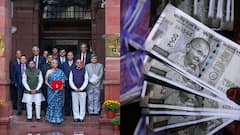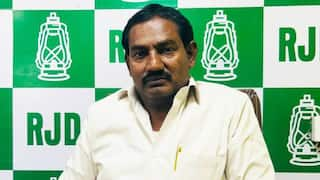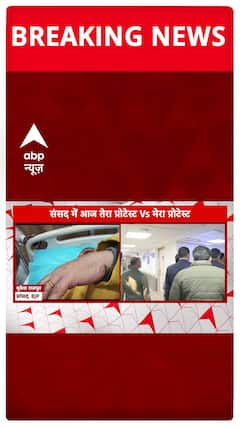Budget 2023: List Of Documents Presented In Parliament Along With The Speech
Here's a list of the documents which are presented during the Budget in Parliament, along with the speech of the Finance Minister

The Budget for the year 2023-24 is around the corner. Finance Minister Nirmala Sitharaman will present the Union Budget on February 1. As this year’s Budget knocks on the door, take a look at the list of documents tabled in Parliament, along with the speech of the finance minister.
1) Annual Financial Statement: The Annual Financial Statement shows the estimated receipts and expenditures of the Government for the current year, previous year, and budget year. The receipts and disbursements are shown under three parts in which Government Accounts are kept viz.
- The Consolidated Fund of India
- The Contingency Fund of India and
- The Public Account of India
The Annual Financial Statement distinguishes the expenditure on revenue account from the expenditure on other accounts, as is mandated in the Constitution of India. The Revenue and the Capital sections together, make the Union Budget.
2) Demands for Grants: The estimates of expenditure from the Consolidated Fund of India included in the Annual Financial Statement and required to be voted by the Lok Sabha, be submitted in the form of Demands for Grants.
The Demands for Grants are presented to the Lok Sabha along with the Annual Financial Statement. Generally, one Demand for Grant is presented in respect of each Ministry or Department. However, more than one Demand may be presented for a Ministry or Department depending on the nature of expenditure.
3) Finance Bill: A Finance Bill is also presented which provides details about the imposition, abolition, remission, alteration, or regulation of taxes at the time of presentation of the Annual Financial Statement before Parliament proposed in the Budget. It also contains other provisions relating to the Budget that could be classified as Money Bill.
4) Fiscal Policy Statements mandated under FRBM Act: The Fiscal Responsibility and Budget Management Act aims to ensure transparency in India's fiscal management systems. The long-term objective of the Act is for India to achieve fiscal stability and to give flexibility to the Reserve Bank of India (RBI) to deal with inflation in India.
The FRBM Act made it mandatory for the government to place the following along with the Union Budget documents in Parliament annually:
i) Macro-Economic Framework Statement: It contains an assessment of the growth prospects of the economy along with the statement of specific underlying assumptions. It also contains an assessment regarding the GDP growth rate, the domestic economy and the stability of the external sector of the economy, the fiscal balance of the Central Government, and the external sector balance of the economy.
ii) Medium-Term Fiscal Policy cum Fiscal Policy Strategy Statement: It sets out the three-year rolling targets for specific fiscal indicators about GDP at market prices, namely, Fiscal Deficit, Revenue Deficit, Primary Deficit, Tax Revenue, Non-tax Revenue, and Central Government Debt. The Statement includes the underlying assumptions, an assessment of the balance between revenue receipts and revenue expenditure, and the use of capital receipts, including market borrowings for the creation of productive assets.
5) Expenditure Budget: The provisions made for a scheme or a programme may be spread over a number of Major Heads in the Revenue and Capital sections in a Demand for Grants. In the Expenditure Budget, the estimates made for a scheme/programme are brought together and shown on a net basis on a Revenue and Capital basis in one place. Expenditures of individual Ministries/ Departments are classified under two broad umbrellas (i) Centres' Expenditures and (ii) Transfers to States/ Union Territories (UTs).
6) Receipt Budget: Estimates of receipts included in the Annual Financial Statement are further analysed in the document “Receipt Budget”. The document provides details of tax and non-tax revenue receipts and capital receipts and explains the estimates. The document also provides a statement on the arrears of tax revenues and non-tax revenues, as mandated under the
FRBM Rules, 2004.
7) Expenditure Profile: This document was earlier titled Expenditure Budget - Vol-I. It has been recast in line with the decision on the plan-non-plan merger. It gives an aggregation of various types of expenditure and certain other items across demands. Under the present accounting and budgetary procedures, certain classes of receipts, such as payments made by one department to another and receipts of capital projects or schemes are taken in reduction of the expenditure of the receiving department.
While the estimates of expenditure included in the Demands for Grants are for the gross amounts, the estimates of expenditure included in the Annual Financial Statement are for the net expenditure, after taking into account the recoveries. The document makes certain other refinements such as netting expenditure of related receipts so that overstatement of receipts and expenditure figures is avoided.
The Expenditure Profile gives the total provisions for each of the ministries arranged under the various categories - Centrally Sponsored Schemes, Central Sector Schemes, Establishment, Other Central Expenditure, Transfer to States, etc. and highlights the Budget provisions for certain important programmes and schemes.
8) Budget at a Glance: This document shows in brief, receipts and disbursements along with broad details of tax revenues and other receipts. This document provides details of resources transferred by the Central Government to State and Union Territory Governments. This document also shows the revenue deficit, the gross primary deficit, and the gross fiscal deficit of the Central Government.
9) Memorandum Explaining the Provisions in the Finance Bill: To facilitate understanding of the taxation proposals contained in the Finance Bill, the provisions and their implications are explained in the document titled Memorandum Explaining the Provisions in the Finance Bill.
10) Output Outcome Monitoring Framework: Output-Outcome Monitoring Framework (OOMF) for Central Sector Schemes (CSS) and Centrally Sponsored Schemes (CSSs) with a financial outlay of Rs 500 crore and more each, will be laid in the House along with Budget 2022-23.
With regard to CS and CSS schemes with an outlay of less than Rs 500 crore each, the output-outcome monitoring framework with the itemised expenditure of the schemes will be prepared by the respective Ministry/Department and the same will be presented in the Parliament along with the Detailed Demand for Grants (DDG).
11) Key Features of Budget 2022-23: The Document is a snapshot summary of the economic vision of the government and the major policy initiatives in the thrust areas of the economy for growth and welfare. Major milestones achieved in fiscal consolidation and management of the Government finances along with a bird’s eye view of the key budget proposals for the fiscal year 2022-23 are also included in the document.
12) Implementation of Budget Announcements 2021-22: The document summarises the status of implementation of the announcements made by the finance minister in the Budget speech 2021-22.
Trending News
Top Headlines






































